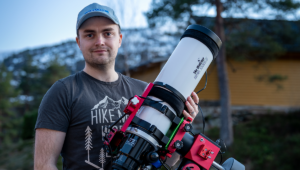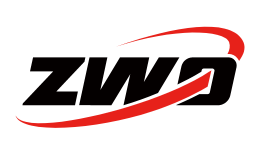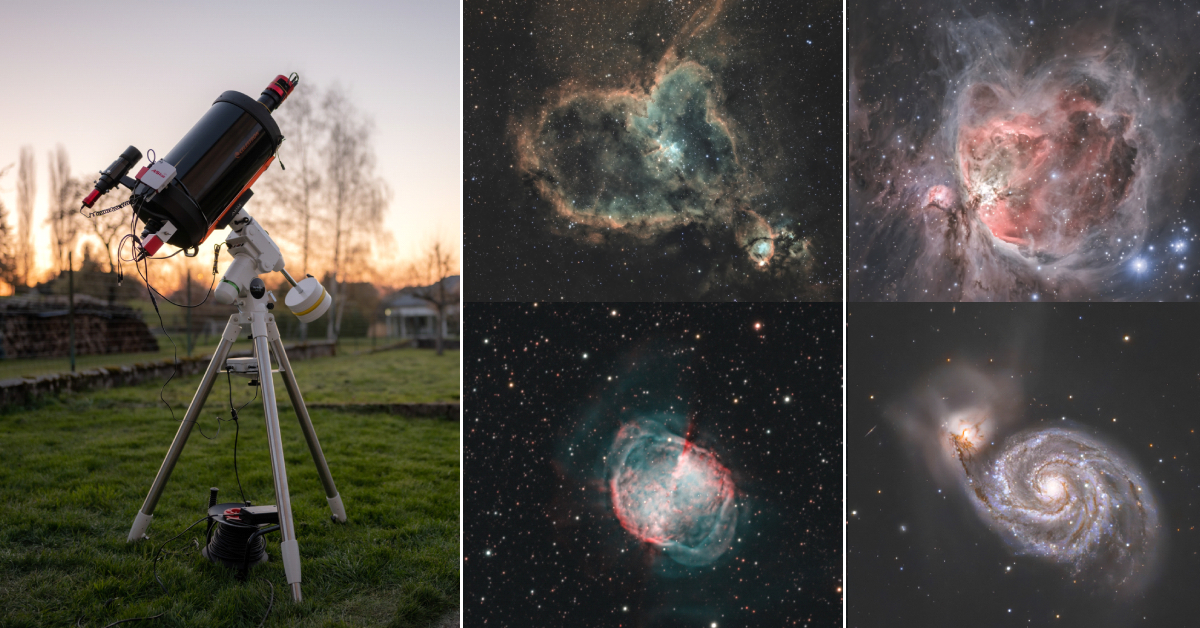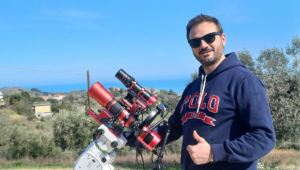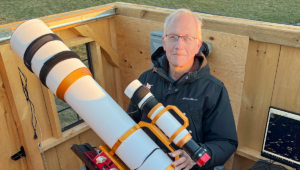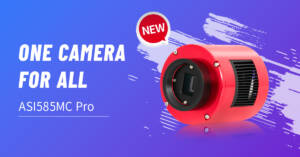Cedric Begue is the winner of ZWO 2020 ASIWEEK #17 and has brought us many extraordinary astronomy photos. To make our ZWOers know this excellent astrophotographer better, we make this interview. Let’s all take a look now.

Q1: At first, congratulation that your nice image won #ASIWEEK! Can you introduce yourself to us?
Thanks! My name is Cedric Begue, I am 37 years old. I live in a small town East of Paris, France. I started taking photos for fun about 10 years ago then got into it more and more.
Q2: It seems to us that you’re a very professional photographer since we saw plenty of great photos on your Facebook including landscape, wildlife, buildings, etc. Can you tell what made you turn to astrophotography?
I am an amateur 🙂 it’s really just a hobby. But I have been fascinated by the science of the universe for a very long time. In the last few years astrophotography of deep sky objects like nebulas and galaxies has become more accessible, and seeing these beautiful things on the internet made me want to do it myself.
One year ago early april 2019 I was taking my first photos, with an equatorial mount and my photo gear, then things happened, I loved it so much that I bought a dedicated camera, guiding equipement, and the ASIair to command everything; instantly improving the quality of the results.

M27, the Dumbell Nebula in narrowband, ASI183MM Pro on Sigma 500mm F4 Sport lens; 3hours Ha + 3 Hours O3.
Q3: What do you think are the differences between astrophotography and other kinds of photography?
It is very different indeed, in some ways it is harder, because the technical part is much more important to get good results, polar alignment, guiding, focusing… It takes some time to know what you are doing with your equipement and to use the tools that assist you.
But!, unlike “regular” photography, for me animals, or landscapes mainly, as long as the sky is clear you know the object is going to be up there and it’s easy to plan perfectly what you are going to do, even over several nights.
When I go out to take photos of animals or travel for landscapes, I can’t know what I will find, there can be nothing, or the light can be terrible, or I can miss the shots.
For this photo of the Heart Nebula in “Hubble palette” color, it took me three nights to get data from the different filters and a total of around 15 hours of exposure using the Nikon 200mm F2 lens and ASI183MM Pro camera. I like being able to take my time to get the photo I want.

IC1805, the Heart nebula. ASI 183MM Pro on Nikon 200mm F2 lens; S2 + Ha + O3 around 5 hours each.
Q4: What equipment do you use for astrophotography? Any pictures of them?
My equatorial mount is the Skywatcher HEQ-5 Pro.
I used for many months my telephoto lenses because they have such great optical quality and very fast transmission. Short focal lengths also allow original composition of large objects in the sky. (500mm F4, 300mm F2.8, 200mm F2, 105mm F1.4)
I recently bought a Schmidt-Cassegrain Celestron C9.25 telescope with the HyperStar V4 that turns it into a 520mm focal length scope at F2.2. It is now my main imaging system.
My cameras are the ZWO ASI 183MM Pro + 294MC Pro, + the 120MM mini as guide cam.
All this is controlled by my original ZWO ASIair, with EFW 8 slots filter wheel and the EAF focuser.
Finally I use narrowband 6nm filters with the 183MM Pro camera, and a light pollution filter or duo narrowband on the color 294MC Pro.

What I use the most now: C9.25 with HyperStar reducer on HEQ-5 Pro.
Q5: How many places have you been for astrophotography? Where is your favorite place? And do you have any unforgettable experience when travelling?
For astrophotography, I am lucky to have a good sky at home (bortle 4 scale and city lights out at 11PM), so my favorite place to take photos is in my backyard for the equipment, and in my house to control everything with the ASIair. 🙂
Now if shooting northern lights counts as astrophotography, I did have an unforgettable experience in Iceland. It was a stunning show.
Another unforgettable experience in astrophotography was taking the Orion Nebula – M42 (also an ASIWEEK winner 🙂 ). It is such a spectacular object, I was amazed to see these colors and shapes live in the app on my phone. I did not have the HyperStar setup at this time, I can’t wait to do it again.

M42 Orion nebula. ASI294MC Pro on Sigma 500mm F4 Sport lens; around 4.5 hours of exposure.
Q6: Do you ever have that kind of thought like “Astrophotography is so difficult that I just want to take a rest for a while”?
No, not at all. It can be more tiring than difficult, to me.
But constantly trying to get better is difficult, one of the photos that was difficult for me to do is the Whirlpool galaxy M51, combining data from both my cameras to get the sharpest possible result with my gear. It spent hours processing the images to practice and learn processing softwares and methods. There is still a lot to learn.

M51 Whirlpool galaxy. Combination of data 3 hours with ASI183MM Pro for luminance, 15 minutes with ASI294MC Pro for color on C9.25 HyperStar.
Q7: What changes and surprises have astrophotography brought you?
It taught me to be more patient I am sure. Seeing so many objects in the sky can, in a way, put into perspective everything that happens in my daily life; feeling that we are part of something much bigger.
And I surprise myself always checking the weather for the night instead of the day like everyone else. 🙂
Q8: As for your winning image M81&M82&Altas Comet, how did you take it and how did you do the composition?
It’s almost a lucky shot to be honest. The weather was too windy to get the large telescope out, I used a much ligher imaging setup with a short telephoto lens and looked for ideas on the internet. I found the wide field of the Integrated Flux Nebula (IFN) clouds of this region would be a nice target. I looked for coordinates on the Stellarium software and used the goto and plate solve funtions of the ASIair as always.
I was surprised to see the comet in the frame on the first photo. The first night was technically not good, it was my first time using this 105mm F1.4 photo lens on astrophoto camera, replacing my other 105mm F1.4 from Nikon. I wanted better and I knew I could do it so I did it again the next night to get it right.
Capturing these dark clouds is quite challenging and require a sky of good quality with low light pollution.

IC7023 the Iris nebula, and SH 2-136 the Ghost nebula. Around 15 hours with ASI294MC Pro on Nikon 300mm F2.8 lens.
Q9: Do you have any suggestions for the newcomers?
Be patient! It will take time to get used to the techical side of astrophotography, don’t give up if things go wrong in the first few weeks. Get the right gear with your budget, things that work well together. Don’t be affraid to ask for advices from the comunity.
For me, what works is to be inspired by the work of others, there are plenty of beautiful images of iconic objects. I don’t say “I will never be able to do that” I say “I want to do that”.

IC434 and NGC2024, the Horsehead and Flame nebulas. Around 5 hours with ASI294MC Pro on Sigma 500mm F4 Sport lens.
Q10: Can you tell how did you know ZWO? How many ZWO products do you have?
I think just looking for cooled astrophotography cameras I noticed ZWO was a very popular brand. I also came across reviews of the ASIair so I bought a complete package with the camera and filer wheel. Today I have a total seven ZWO products, cameras, EAF filter wheel, guide scope, ASIair.. plus adapters for Nikon mount lenses, I really like how all works well together.
Q11: What do you care most when buying a dedicated astronomy camera?
That would be the pixel size first. Then the noise. My 183MM Pro with very small pixels is fantastic combined to the short and fast focal lengths of my lenses. While the 294MC Pro has bigger pixels, more dynamic range for very deep color images. I hope to get the 2600MC Pro in the coming months, this new generation of sensors is really great. And if a monochrome sensor with even smaller pixels comes out one day I’ll be very excited too.

NGC7000 The North American nebula and IC5070 the Pelican nebula. Around 5 hours in narrowband Ha with ASI183MM Pro on Nikon 105mm F1.4 lens.
Q12: Do you know our ASIAIR PRO? Are there any features you feel interested?
Yes I know the ASIAIR PRO. I am interested in the built-in DC outputs especially, and live stacking for a more confortable experience. But the PRO features are not so critical for my use, the original is still great. I keep an eye on updates as they keep coming and the PRO perhaps having more avantages thanks to its greater processing power in the furure.
Planetary imaging support with SER format video file would be great. I enjoy deep sky objects but also moon images using the ASI183MM Pro on my C9.25 scope. The relatively large sensor size allows to capture large portions of the moon so it’s easy to stitch a complete panorama with great fine delail.

Moon detail with ASI183MM Pro on Celestron C9.25 @ F10.
Q13: What’s your impression of ZWO? Do you have any feedback or suggestions to us?
I believe ZWO is doing a great job, the products are attractive and the big strengh is that all works very well together, the most important things to control your imaging system are available. Regular updates on the ASIair are a big plus, ZWO is taking seriously the feedback from their customers.
